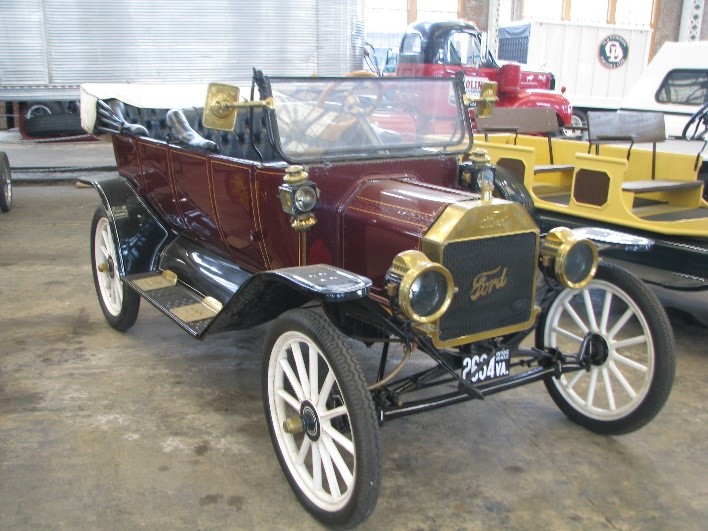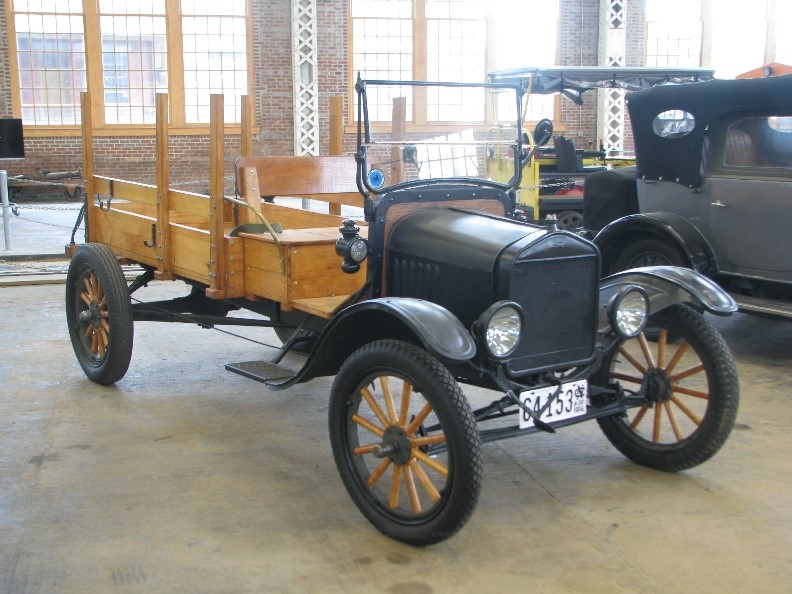
Ford car at the Transportation Museum in Spencer in North Carolina.
In the Beginning
We like to believe that we are in the new age of the vehicle. The truth is, we now trod where we, as an industry, have been before, more than 100 years ago. The end of the 19th and beginning of the 20th century, there were many vehicle manufacturers, and now, we are witnessing a resurgence of vehicle manufacturers for example Tesla, Faraday, and Rivian to name a few.
Historical Record
It is difficult to believe that once upon a time, there were many automotive manufacturers in the United States (the world actually). Over the decades, like any industry, we see loss of manufacturers leading to where we are today. Skeptical? All you need to do is visit the Wikipedia List of defunct automobile manufacturers of the United States. There have been many automotive manufacturers over the decades. Many of these manufacturers survived only a few years. No doubt the capability of the product offering, along with cost pressures had some influence on the longevity or lack of it. There was assimilation of some manufacturers by a more profitable organization perhaps to extend the product line or market region or demographic. Some of these defunct vehicle manufacturers produced steam vehicles, imagine that, steam cars. Some designed and built electric vehicles. Surprise! Electric vehicles more than 100 years ago.
In 1900, *40% of cars were powered by steam, 38% by electricity and a mere 22% by gasoline.
There are times when history repeats, and perhaps we are in one of those events presently. At one time (not so long ago) in the United States, we referred to the Big Three (Ford, General Motors, and Chrysler).
These companies still exist, but not exactly as they did in the olden days. We now witness a resurgence in vehicle manufacturers, specifically electric vehicles, and developing these vehicles is a significant departure from internal combustion engines.
What could this mean, practically
A significant source of the cost of developing a vehicle comes in developing the drive line, that is the engine block, transmission, and axles. The engine blocks alone are complicated. It is usually aluminum and cast from molds comprised of many cores. An interesting video on the process found here.
Drive train development encompasses everything from performance such as acceleration, handling, and fuel economy, to emissions related standards and objectives.
Internal combustion engines take time to design and develop. This requires precision, and is costly to develop and manufacture. Additionally, we will require specialized tools such as a dynamometer for testing things like torque and horsepower, as well as a key component for meeting the vehicle emission regulatory requirements.
The move to electric eliminates some of these hurdles, while creating perhaps others.
No internal combustion engine development required. The suspension systems may still require adaptation due to vehicle weight distribution, substitute engine with batteries.

There was a time a few years back (maybe still happening), where an electric car manufacturer would purchase a roller from an vehicle original equipment manufacturer (OEM). A roller is a full vehicle without the drive line that an electric car manufacturer would purchase and add the batteries, electric motor systems, along with the controls and special displays.
Fred Starkey and I visited one such company near Charlotte North Caroline in the early 2000’s.
There are downsides to battery vehicles, and we will discuss these in a later article. For now, let’s just explore the transition to electric vehicles and what that might mean for vehicle manufacturers.
What if?
My colleague, Fred Starkey, I have known each other since the mid-1990’s. We have had discussions about the impact of battery vehicles and the possibility of developing vehicles faster with lower costs, and another by product, with fewer mechanical parts.
This reduction of moving mechanical parts introduces the possibility of higher quality and reliability.
What if there were regional vehicle manufacturers as was once the case the end of the 19th and beginning of the 20th centuries. The automotive industry may never be a cottage industry, but one could envision small regional manufactures. In this way we may once again end up with a variety of vehicle manufacturers, perhaps making the most of the resources in that area, and perhaps more importantly, developing vehicles specific for the regional demands.
Vehicle Development
There still will be proprietary differences in the vehicle analogous to the difference in horsepower, torque, and handling characteristics.
The development of these vehicles may also tap into the regional talent. The Covid pandemic has pushed new ideas of working, specifically team members spending significant time working from home. In this way, regions will develop competencies based upon the vehicle designs specific to that regional manufacturer. Consider those regions with automotive focused universities:
| University of Michigan, Michigan State University | Indiana University / Purdue University Indianapolis |
| Cornell University | Kettering University |
| University of Texas at Austin | Virginia Polytechnic Institute |
| University of California, Davis | California Po0lytechnic State University |
| Clemson University | Georgia Institute of Technology |
Lessons for Electric Vehicle development
The remaining conventional vehicle developers and manufacturers have been around for a long time, and are using that experience to develop electric and hybrid vehicles. They have developed processes to meet the customer and market challenges that address regulatory compliance, margins, and high-volume production. Additionally, these processes are designed to meet the risks due to failure, the consequences of vehicle failure on the customer, the company and society at large.
Imagine a braking problem in an electric vehicle as an example.
Conventional vehicle manufacturers have developed approaches to gathering the customer information and prioritization of those requirements in a way that ensures the developed product is something a customer will purchase.
We can relate tales of electric vehicle manufacturers have developed a product, then take it to the customer, only to find out the cost of changes to make this work for the customer are so high as to put the company out of business.
Customer input at the beginning of the development cycle is important. This is where the product attributes and process (manufacturing attributes) are identified and controlled throughout the development of the product and manufacturing line.
The quality of the vehicle is due to the sum of the parts. For example, in discussions with some electric vehicle manufacturers, they seem have no concept of the production part approval process (PPAP) and the myriad of other tools employed by long standing automobile manufacturers and suppliers. Electric vehicles require manufacturing, and the supply chain that must be effectively engaged, to timely deliver quality parts.
Electric vehicles will undergo the same environmental stimuli that a conventional vehicle, at least theoretically. That is, we can drive an electric car through the desert, or in the upper regions of Canada.
From my experience, there are no “do not drive on unpaved roads” or “at restrictive temperature range” for electric vehicles.
This requires understanding of the component parts capability as well as effective integration of the product into a system to ensure the system performance. There is initial product quality, and the quality over time- reliability, that can impact the business due to excessive warranty or rework costs. This can be so severe that we lose customers.
Closing Arguments
Electric vehicles are not new. From the earliest of times of the automobile, there were manufacturers that were using electric power. There have been approximately 70 electric vehicle manufacturers in the early years.
It is true that, just because some organizations in your industry do a thing (in this case use some set of processes to develop vehicles), it does not necessarily follow that electric vehicle developers and manufacturers should adopt these same or similar practices.
However, it is short sighted to summarily dismiss what has taken years to create.
These are still vehicles, subjected to the same manufacturing and supply chain disruption.
The parts used for these vehicles, are going into vehicles that have the same safety expectation, operating in the same environments as internal combustion vehicles. These automotive processes ranging from developing and qualifying the product and process, to post launch activities to support the transition from small volume to larger volume manufacturing and continuous improvement.
It is not necessary to reinvent the wheel- mild pun intended. As part of our learning, we can see what has gone before, and consider does it apply today, to us, in this instance.
What is different about electric vehicle design and manufacturing that would lead one to the conclusion that what has gone before is a waste of time and effort? That question should be explored
*In 1900, 40% of cars were powered by steam, 38% by electricity and a mere 22% by gasoline.[1]
[1] https://inhabitat.com/over-a-third-of-all-cars-were-electric-a-century-ago/












More Stories
Professional vs. DIY Tinting: What You Should Know
New updated edition of “PXIMate” reference guide for T&M engineers available from Pickering Interfaces
5 Mistakes That Can Ruin Your Car Accident Claim